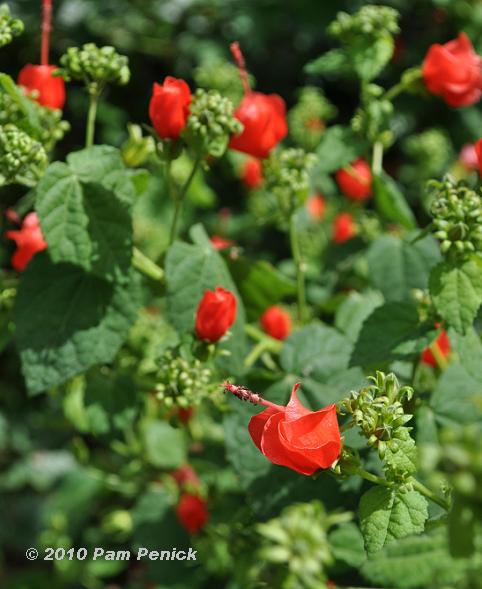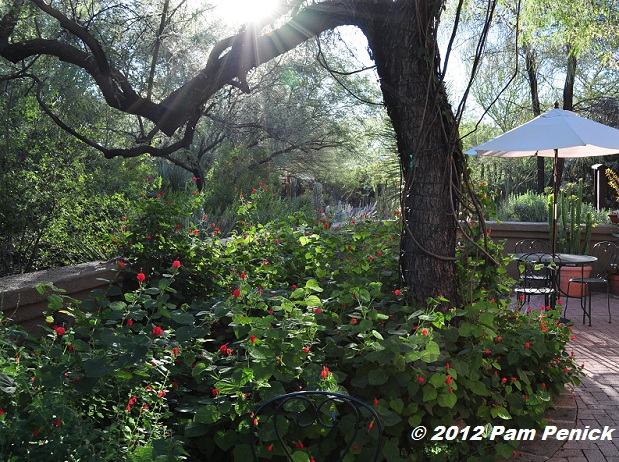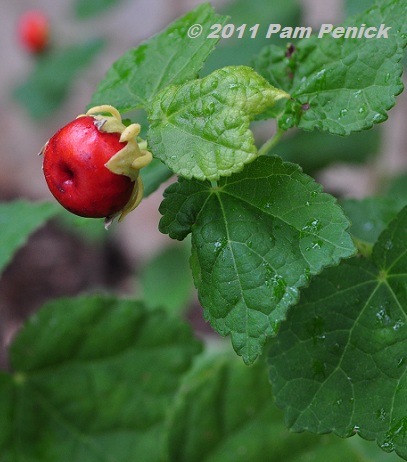Plant This: Turk’s cap
Death Star-adapted plants tend to be small-leaved and airy, the better to retain precious water. But our native Turk’s cap (Malvaviscus arboreus var. drummondii) defies that expectation with vaguely heart-shaped leaves the size of a napkin scrounged out of your car’s glove box, and just as crinkled.
For the foliage alone, which the deer ignore in my garden, Turk’s cap would be worth planting. But the twisted, tomato-red flowers that blaze among the leaves from late spring through fall make Turk’s cap one of my favorite perennials for shade or part sun. Hummingbirds adore these blossoms, and you’ll see them zipping around for a drink all summer long.
Turk’s cap will grow in either sun or shade, although it can look wilted by the end of the day in full sun. For that reason I prefer to give it afternoon shade. If you garden under live oaks, as I do, you’ll find Turk’s cap thrives in those conditions. This photo was taken in Tucson, Arizona, showing that Turk’s cap can be grown west of its native range.
Flowers give way to small, red fruits around Thanksgiving, which birds enjoy. It dies to the ground after a hard freeze, and I usually leave the stems standing until my mid-February cut-back, when I prune them to about 6 inches. This year I’m finding a lot of Turk’s cap seedlings in my island bed out front, but they pull easily.
In my garden, Turk’s cap grows to about 4 or 5 feet high and 3 to 4 feet wide, and it pairs nicely with bamboo muhly (Muhlenbergia dumosa) in sunnier spots and inland sea oats (Chasmanthium latifolium) in shadier ones. It’s said to be root-hardy to zone 7b.
If the standard red Turk’s cap is old hat for you, you might enjoy trying other cultivars, like the pink ‘Pam Puryear’, also called ‘Pam’s Pink’, or the hard-to-find and harder-to-grow (at least for me) white Turk’s cap. There’s also a variety from Mexico called ‘Big Momma’, whose red flowers are larger and showier.
Note: My Plant This posts are written primarily for gardeners in central Texas. The plants I recommend are ones I’ve grown myself and have direct experience with. I wish I could provide more information about how these plants might perform in other parts of the country, but gardening knowledge is local. Consider checking your local online gardening forums to see if a particular plant might work in your region.
All material © 2006-2015 by Pam Penick for Digging. Unauthorized reproduction prohibited.





Hey Pam – you know those fruits are edible for us humans too. There’s not much flesh surrounding the seeds, but it tastes just like watermelon!
Does it really? That’s a pretty small watermelon though. —Pam
Pam, I hope you will keep trying the white version. I’ve had mine for many years and love the white flowers in the shade. It’s in an area of the yard that rarely gets watered by me and it has proven to be a hardy trooper! I’ve also received the pink version this year at a plant swap, so I can’t wait until they take hold and bloom for me!
I have one white Turk’s cap survivor, Patty, and it seems to be doing pretty well. It’s not large, but it’s happier since I moved it to a shadier spot. I hope your pink one takes off soon! —Pam
I just found the alba version available on Lazy S’s Farm Nursery website. Apparently they just added it this month. It does say it needs some shade.
The red ones are gorgeous in your garden!
Thanks for the tip about the white Turk’s cap, Marilyn. —Pam
I love Turk’s cap but they just haven’t been reliable for me in zone 8a. Sometimes they’ll hang on but not bloom. But I keep trying, of course. 🙂 Same for bamboo muhly, which I’ve now got in pots.
I’m interested to hear that, Jean, since the sources I checked said Turk’s cap was root hardy to zone 7b. That’s too bad. —Pam
Turk’s cap is a favorite in my Southeast Texas garden as well. Not only do hummingbirds love it, but so do the butterflies and native bees. Here, it blooms just about year-round unless we get an unusually cold winter.
Lucky you, and lucky hummers! —Pam
I did not know they had alternative colors, see what you did Pam- now I have to spend more money on plants.
I was introduced to the red Turks cap when I was a child at my grandmothers house and have always loved it as an easy care plant that performs well in the shade in south Texas. I will have to search for these alternative colors now. Hope I can get the pink or white to grow for me.
You’ll find the Pam’s Pink pretty easily, I expect, James. The white variety is harder to find, at least in Austin, probably because it’s more finicky to grow. See one of the above helpful commenters for information about where to find it online. —Pam
OMG I love our Turks’ Caps!! We have 3 Big Mommas, one of which has really lived up to her name, standing at over 8 feet tall (in the one year we have had her) and about 4 feet wide. We also have the pink and white varieties, both of which don’t seem to mind Houston weather, though the white one we have found to be more temperamental and doesn’t like its current location. All are awesome. Thanks for doing a post on this underrated plant.
Eight feet tall is BIG, all right. My regular reds are 5 to 6 feet, thanks to all the rain, and I thought that was tall. —Pam
Don’t forget that butterflies like this plant too. Lovely.
I hadn’t realized that butterflies like Turk’s cap, Lisa. Are you growing the same plant up in Indiana? —Pam
I remember being told years ago I should only plant Turk’s Cap where I wanted a mini-grove of them, because they’d spread out and root in and I’d have a hard time getting them OUT again if I changed my mind. Somehow that only seemed encouraging. And sure enough, years later, I have a stand where once there was a single lonely plant. And no, I never changed my mind, except to want more-more-more. I did try a pink but it never really took off. Haven’t seen the white but would love to try one of those. Imagine!
Earlier this year, when I spotted the first bloom on a new plant I put in last year (four inch pot sized) I was ecstatic and encouraged it to grow and spread to its heart’s desire. (Yes, my neighbors are used to my talking to the plants – why do you ask? : ) Turk’s Caps are just about everything an Austin area gardener could ask for. Well deserved tribute to a great plant!
I have a grove of Turk’s cap too, Deb. It does like to spread, and that’s OK with me too. It’s trouble-free, blooms beautifully spring through fall, and looks great until a hard freeze. I love it. —Pam
Good reminder to use Turk’s Cap, plus some varieties of it…I rarely see it here, but it’s always thriving when I do. It is now on my list. We’re past our hottest weather and into some – gasp – humidity, daily storms, and even more clouds.
Just listened to the ATX band Ringo Deathstarr online!
Ringo Deathstarr — ha! Maybe I’ll see them at ACL this year. —Pam
I had this plant but lost it. I do love it and need to replace it.
I’m intrigued to hear that you had it in your Alabama garden, Phillip. Jean says she lost it in her Louisiana garden too. —Pam
I certainly agree…Turk’s cap is a great plant that is loved by humans and wildlife alike. As crazy as this sounds, there are many plants that I could grow in the crappy conditions of Texas that I can’t here in SC. But then again, there are plants that grow here that can’t survive there. It’s a trade off! ~Julie
It sure is, Julie, no matter where you garden. —Pam
Beautiful photos!
Turk’s Cap grows wonderfully well here in northeast Mississippi in full sun. We have had a lot of rain this Summer, so it is really growing tall this year.
Have a beautiful week-end!
I’m delighted to know that Turk’s cap grows well for you in Mississippi, Lea. It obviously does well in acidic soil as well as alkaline. —Pam
I have Turk’s Cap volunteering everywhere in my yard this year. It looks great, so I’m leaving it alone. I am trying the Pam’s Pink for the first time. Plants look good – just not as showy as the red.
Yes, that’s true. Pam’s Pink is a soft pink, not a showy hot pink. It looks quite nice with the pink variety of Salvia coccinea, by the way. —Pam
I have had great success with Turks Cap in Lubbock, Texas. Wind, Texas dry heat to 110*, sandstorms and -5* in the winter and just last year… hot 95* to below freezing weather in one 24 hour period! If anything can survive that I love it! Turks Cap looks great 9 months out of the year for me!
It’s one tough plant, all right. —Pam
I live in New Braunfels on clay soil. Will it survive waterlogged soil like we had in May?
Mary, the Wildflower Center’s website says it’s naturally occurring along streams in central Texas. It would be adapted to seasonal flooding in that case. —Pam
Thanks Pam. In that case I’m adding it to my “keep an eye out for deals” list.
I tried to transplant a mature Turk’s Cap and had a very difficult time .. gave up. do they not like to be moved?
Also, they are in full shade and have never bloomed very well. I have always read they like full shade. The foliage thrives and is beautiful.
Natives often resent being moved, Wendy, because their deep roots are damaged in the process. But it may have been that it went into shock and/or didn’t get enough water to recover. You didn’t say when you tried to move it, but generally it’s best to transplant mature shrubs and perennials in cooler months in fall or early spring.
Full shade is fine for Turk’s cap. I’m not sure why yours aren’t blooming well, as they sound otherwise healthy. If they’re under a tree canopy, is it possible to limb up the tree a bit to give the plants below a little more light? —Pam